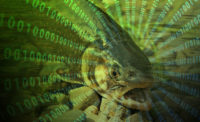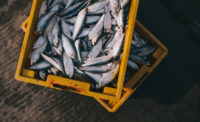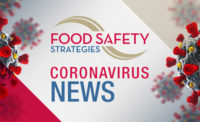In 2013, the ‘horsemeat scandal’ sent tremors through the European food industry. The fraudulent replacement of beef with cheaper equine alternatives in burgers and convenience food left consumers and retailers reeling, alarmed that they had fallen victim to the largest food fraud in decades.
The scandal not only highlighted the shortcuts being made by food manufacturers in their attempts to compete for the lowest price, it emphasized the complexity of global food supply chains and the challenges in monitoring every step. Almost overnight, the importance of traceability—the ability to track any food through all stages of production, processing and distribution—became high on public and political agendas.
‘Food scandals’ can leave consumers feeling duped, misled and distrustful of retailers and brands. They can also lead to people eating foods that violate their religious or moral values; or worse still have impacts on their health.
Recognizing the negative impacts of incorrect labelling, governments around the world have responded. The Food Standards Agency in the UK, the U.S. Food and Drug Administration, the European Food Safety Authority and Food Standards Australia New Zealand, to name a few, commit extensive resources to ensuring the safety and correct labelling of our food. But the problem persists—and responsibility is often laid at the feet of food suppliers.
Mislabeled Seafood: A Widespread Form of Food Fraud
Seafood fraud, the selling of seafood products with a misleading label, description or promise, has become a widespread form of food fraud as the most highly traded food commodity in the world; increased market demand for fish coupled with weak legislation has incentivized the renaming, substitution and mislabelling of seafood to reap higher profits. Not only does this illegal activity threaten the bottom line of honest fishers and seafood traders, it undermines the progress being made by sustainable fisheries.
The need for traceability in the seafood sector is now widely recognized. Major seafood import markets such as the U.S., Japan and the EU have introduced traceability components to their import regulations in recent years. But despite increasing legislation, a recent global analysis revealed that on average 30 percent of seafood across the world is misdescribed or mislabelled,[1] with figures as high as 43 percent reported in some species-specific studies.[2]
The Problem with Fish: Mislabeling Motivations
Although it is possible for seafood to become unintentionally mixed with different species at various points along the supply chain, intentional seafood fraud is motivated by profit. Scientific investigations have repeatedly revealed higher rates of mislabeling among premium, sought after fish like Atlantic bluefin tuna (Thunnus thynnus) and wild-caught chinook salmon (Oncorhynchus tshawytscha), and lower rates in convenience seafood like fish fingers and processed seafood sticks. Higher rates of mislabelling have commonly been reported in restaurants and take-away outlets than in food retailers.
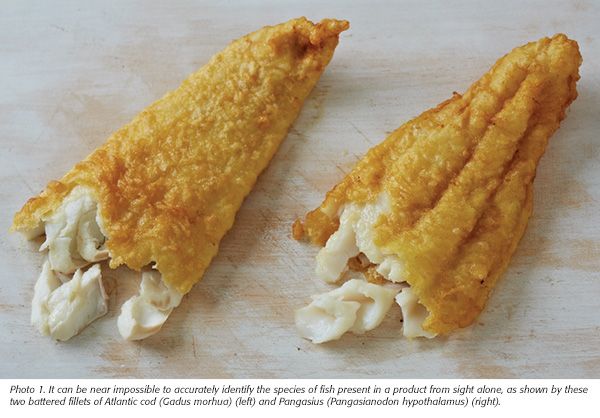 In restaurants, unlabelled products can quickly be substituted to boost profits or meet gaps in supply. One of the more profitable seafood substitutions revealed in a Belgian restaurant was the replacement of Atlantic cod (Gadus morhua; typically costing €20–25/kg) with the farmed Vietnamese river catfish ‘pangasius’ (Pangasianodon hypothalamus; typically €4/kg). Both species share similar flaky white flesh which is likely to go unnoticed by consumers, while dishonest traders reap the benefits. Can you spot the difference in Photo 1?
In restaurants, unlabelled products can quickly be substituted to boost profits or meet gaps in supply. One of the more profitable seafood substitutions revealed in a Belgian restaurant was the replacement of Atlantic cod (Gadus morhua; typically costing €20–25/kg) with the farmed Vietnamese river catfish ‘pangasius’ (Pangasianodon hypothalamus; typically €4/kg). Both species share similar flaky white flesh which is likely to go unnoticed by consumers, while dishonest traders reap the benefits. Can you spot the difference in Photo 1?
Consequences of Seafood Fraud
The implications of seafood mislabelling can be alarming and wide ranging.
IUU: Illegal, unreported and unregulated (IUU) fishing refers to fishing activities that do not comply with national, regional or international fisheries conservation or management legislation or measures. A global analysis of IUU fishing from 54 countries, comprising 75 percent of global catch, revealed that an estimated 11–26 million tons of IUU fish are landed each year, representing a loss of between $10B and $23.5B to the fishing industry.[3]
Consumer health implications: Not only can mislabelled seafood affect ocean health, it can have health implications for consumers. Although not all traceability systems specifically include food safety requirements, the simple substitution of one fish for another can lead to consumers unwittingly purchasing fish that should be presented with health warnings.
Consumer deception: Consumers are increasingly demanding fish from sustainable sources often using ‘fish to eat/avoid’ guides to aide their purchasing choices. Others make an ethical decision to choose wild-capture fish over farmed products. Where fish are incorrectly labelled, these consumers could unwittingly be eating options that are less sustainable, or that do not meet their ethical criteria.
Finding a Solution
Despite the clear threats posed by seafood fraud, there is hope. A number of voluntary supply chain traceability schemes have been developed to ensure the integrity of seafood supply chains. The Marine Stewardship Council’s (MSC) Chain of Custody Standard is one such scheme, covering over 3000 seafood suppliers, distributors and processors across the world. It assures consumers that the MSC-labelled seafood they buy has been sourced legally from a sustainably managed source, has not been mixed with uncertified seafood and can be traced along the supply chain from ocean to plate.
Companies certified against the Chain of Custody Standard are audited regularly to ensure that they meet robust traceability requirements: MSC-certified seafood can only be purchased from certified suppliers and must be identifiable at all times, segregated from non-MSC-certified seafood and sold with the correct paperwork identifying it as certified. This means that seafood sold with the blue MSC label can be traced back to the ocean, giving buyers confidence in its provenance and sustainability.
How DNA Works
The use of DNA testing (Figure 1) has revolutionised seafood traceability over the past decade, and there is ongoing research and development to improve efficiency and accuracy for an ever-growing number of species. It provides a vital tool to verify the authenticity of seafood products, deterring the commercialisation of endangered and vulnerable fish species and to preventing seafood fraud.
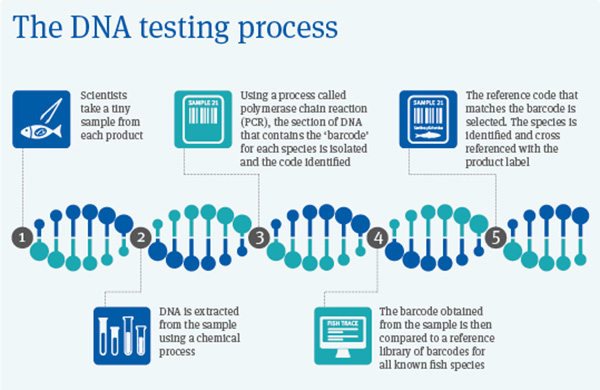 The color, shape and texture of fish and other marine species can often be altered beyond recognition during the manufacture of seafood products. This makes it near impossible to accurately identify the species of fish present in a product from sight alone.
The color, shape and texture of fish and other marine species can often be altered beyond recognition during the manufacture of seafood products. This makes it near impossible to accurately identify the species of fish present in a product from sight alone.
But regardless of how a seafood product is stored (fresh, canned, frozen), and what form it is in (fillet, eggs, fin, processed product), even the smallest fragment will contain a unique genetic code.
By comparing a particular segment of DNA with a reference library holding the genetic codes of most fish species, scientists can identify exactly which species is present in a sample and, for some species with very distinct populations, where in the world that species was caught.
How We Know It Works
The MSC regularly monitors this supply chain in order to ensure that our strict Chain of Custody requirements are followed correctly.
In combination with product tracebacks and supply chain volume reconciliations, the MSC uses a biannual DNA testing program to monitor the effectiveness of the MSC Chain of Custody certification program, and to verify the authenticity of products carrying the blue MSC label.
Since 2009, DNA tests on hundreds of MSC-certified seafood products, all over the world, have shown that incidence of mislabeling amongst MSC-labelled seafood are less than 1 percent, and the latest results have revealed that 99.6 percent of MSC products were correctly labelled
Given industry levels of mislabeling, these results are quite remarkable. But we’re not complacent. Any non-conformities are thoroughly investigated and improvements made to ensure that the MSC Chain of Custody Standard continues to be applied correctly.
For example, the results of our latest round of DNA testing revealed that a product labelled as containing southern rock sole, was in fact northern rock sole. An investigation was immediately launched but did not show any evidence of the deliberate substitution of an MSC-certified species with a non-certified species, but rather the accidental mix-up of two closely related species, both of which had been caught in MSC-certified fisheries. Actions have now been taken to ensure that this error does not reoccur.
The results of the MSC’s DNA testing program are very positive. They assure consumers that the MSC seafood that they buy has been sourced from a sustainably managed source, has not been mixed with non-certified seafood and can be traced along the supply chain from ocean to plate.
Looking to the future, the scope of the MSC’s testing program will be broadened to include more seafood products and will explore the use of new technologies to verify the authenticity of products that are more difficult to test using DNA.
Lucy Anderson, Ph.D., is the science communications manager at the MSC.
References
1. Pardo, MÁ, E Jiménez and B Pérez-Villarreal. 2016. “Misdescription Incidents in Seafood Sector.” Food Control 62:277–283.
2. usa.oceana.org/sites/default/files/salmon_testing_report_finalupdated.pdf.
3. Agnew, D and CT Barnes. 2004. “The Economic and Social Effects of IUU/FOC Fishing: Building a Framework,” in Fish Piracy. Combating Illegal, Unreported and Unregulated Fishing, 19–49. Paris: OECD.
From Ocean to Plate: Ensuring Traceable Supply Chain in the Seafood Industry


